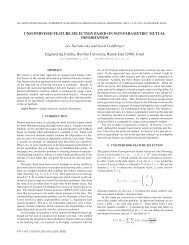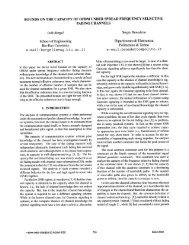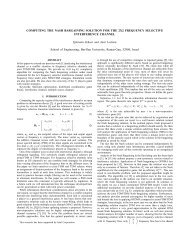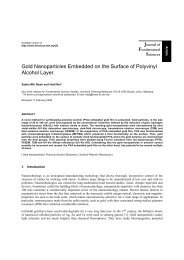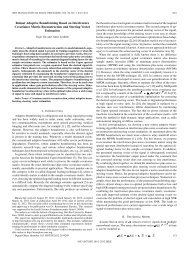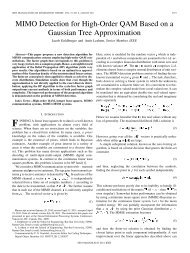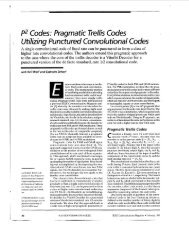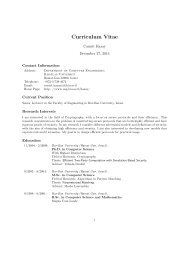Microfluidic single-cell real-time PCR for comparative analysis of ...
Microfluidic single-cell real-time PCR for comparative analysis of ...
Microfluidic single-cell real-time PCR for comparative analysis of ...
Create successful ePaper yourself
Turn your PDF publications into a flip-book with our unique Google optimized e-Paper software.
protocol19| Incubate the <strong>cell</strong>s with 20 µl <strong>of</strong> Alexa Fluor 647–conjugated mouse anti-human SSEA-4 per 1 × 10 6 <strong>cell</strong>s and 5 µl <strong>of</strong>Alexa Fluor 488–conjugated mouse anti-human Tra-1-60 per 1 × 10 4 <strong>cell</strong>s <strong>for</strong> 30 min on ice.20| Wash the <strong>cell</strong> pellet with 600 µl <strong>of</strong> DPBS. Centrifuge the <strong>cell</strong>s at 200g <strong>for</strong> 5 min at 4 °C, and then discard the supernatant.21| Resuspend the <strong>cell</strong>s in 200 µl <strong>of</strong> FACS buffer right be<strong>for</strong>e sorting and keep them on ice. CRITICAL STEP Always keep the <strong>cell</strong>s on ice. Once the <strong>cell</strong>s have been resuspended in FACS buffer, sort them immediatelyto avoid possible negative effects <strong>of</strong> the FBS on pluripotent <strong>cell</strong>s.FACS sorting ● TIMING 30 min22| Add 10 µl <strong>of</strong> PI per 1 × 10 6 <strong>cell</strong>s to the <strong>single</strong>-<strong>cell</strong> suspension just be<strong>for</strong>e <strong>cell</strong> sorting.23| Sort <strong>single</strong> <strong>cell</strong>s directly into the wells <strong>of</strong> a 96-well plate containing the RT-STA mix (from Step 4). Remember not to sort<strong>cell</strong>s into the dedicated wells <strong>for</strong> positive and negative controls. CRITICAL STEP Sort the <strong>cell</strong>s in the same plate that is used <strong>for</strong> the RT-STA <strong>PCR</strong>. Always keep the 96-well plate on ice.24| Cover the 96-well plate with an optical adhesive film.© 2012 Nature America, Inc. All rights reserved.25| Mix the samples by flicking the 96-well plate.26| Spin down the 96-well plate briefly to ensure that no drops are adhering to the well walls. PAUSE POINT The samples can be run immediately or stored at − 20 °C <strong>for</strong> ~3 months.Reverse transcription and specific target amplification ● TIMING ~2 h27| Place the 96-well plate in a thermal cycler.28| Run the sample <strong>PCR</strong> according to these parameters:50 °C <strong>for</strong> 15 min70 °C <strong>for</strong> 2 min18 cycles <strong>of</strong> 95 °C <strong>for</strong> 15 s and 60 °C <strong>for</strong> 4 minHold at 4 °C29| Add 10 µl <strong>of</strong> TE buffer to each sample. The final sample volume is now 20 µl. CRITICAL STEP Any dilution between 1:2 and 1:5 is possible. PAUSE POINT The specific cDNA can be stored at − 20 °C <strong>for</strong> ~3 months be<strong>for</strong>e running the Fluidigm chip. It should bethawed only right be<strong>for</strong>e loading the chip.Sample preparation <strong>for</strong> <strong>real</strong>-<strong>time</strong> <strong>PCR</strong> ● TIMING 1 h30| To prepare the assays and samples to be loaded onto the Dynamic Array IFC, divide a 96-well plate into two halves; usethe left side <strong>for</strong> assays and the right side <strong>for</strong> the cDNA samples. Always keep the 96-well plate on ice and protect it fromlight as much as possible.31| Assay mix: in a total <strong>of</strong> 48 wells, add 3.75 µl <strong>of</strong> the 2× assay loading reagent per well and 3.75 µl <strong>of</strong> each 20× Taqmanassay (from Step 3) used <strong>for</strong> the RT-STA. CRITICAL STEP Note that at this point there is only one Taqman assay in each well, and no longer a pool <strong>of</strong> all the Taqman assays.32| Sample mix: in a total <strong>of</strong> 48 wells, add 3.38 µl <strong>of</strong> the cDNA obtained during the RT-STA from Step 28, 3.75 µl <strong>of</strong> TaqmanGene Expression master mix and 0.375 µl <strong>of</strong> 20× gene sample loading reagent.Chip priming ● TIMING 20 min33| Take a BioMark 48 × 48 Dynamic Array <strong>real</strong>-<strong>time</strong> <strong>PCR</strong> chip from its bag. Avoid touching the center <strong>of</strong> the chip. CRITICAL STEP Use the BioMark 48 × 48 Dynamic Array <strong>real</strong>-<strong>time</strong> <strong>PCR</strong> chip within 24 h after opening the package.834 | VOL.7 NO.5 | 2012 | nature protocols



